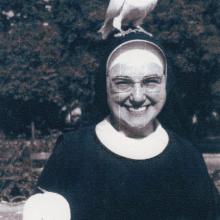nun
The new Peacock TV series Mrs. Davis has the most unhinged first 15 minutes of possibly any show I have ever seen. Men burn at the stake, heads roll, water is walked on, blood fountains.

‘The Vale of Rest’ by Sir John Everett Millais, Bt. Oil paint on canvas, 1858-1859. Photo via Tate / CC-BY-NC-ND 3.0 (Unported)
In Lauren Groff’s newest novel, Matrix, monastic life in the High Middle Ages serves as a stunning backdrop for the story of Marie, a nun who feels “her greatness hot in her blood.” Marie arrives at an English abbey as a reluctant teenager, at the appointment of her queen, Eleanor, who expects Marie to become abbess and save the Crown from the public shame of a royal abbey where nuns die of starvation and disease.

Sr. Carmen Sammut. Image via Rosie Scammell / RNS
Catholic sisters globally would be better equipped to carry out their work if they could become deacons, the head of a global network of nuns has said, an important marker in the sharp debate over women deacons that Pope Francis opened last week.
“We are already doing so many things that resemble what a deacon would do, although it would help us to do a bit more service if we were ordained deacons,” Sister Carmen Sammut, president of the International Union of Superiors General, or UISG, told RNS.
We cannot control or shape the place of our birth. It gives us our bounds for understanding ourselves on this earth. It is difficult to grow beyond our background to include others who are different within the scope of our compassion. Most often we are inclined to feel loyalty only to people who are similar to us in critical regards.

Sister Monica, shown outside her home, has spent her career ministering to transgender people. Photo via Philip Scott Andrews / RNS
Sister Monica lives alone in a small house at the edge of a Roman Catholic college run by a community of nuns.
She doesn’t want to reveal the name of the town where she lives, the name of her Catholic order, or her real name.
Sister Monica lives in hiding, so that others may live in plain sight.
Now in her early 70s and semiretired because of health problems, she remains committed to her singular calling for the past 16 years: ministering to transgender people and helping them come out of the shadows.
Debt from college loans makes some men and women postpone joining a religious community, according to a survey of men and women professing final vows in a religious order.
Ten percent of those who professed final vows in 2013 had an average amount of $31,000 in college debt and the average length of delay was two years, according to “New Sisters and Brothers Professing Perpetual Vows in Religious Life: The Profession Class of 2013.” The annual survey was conducted by the Georgetown University-based Center for Applied Research in the Apostolate (CARA).
Read the entire survey here.
SYRACUSE, N.Y. — Sister Kateri Mitchell was born and raised on the St. Regis Mohawk Reservation along the St. Lawrence River. She grew up hearing stories about Kateri Tekakwitha, the 17th-century Mohawk woman who will be declared a saint in the Roman Catholic Church on Sunday.
She has long admired Tekakwitha for her steadfast faith and her ability to bridge Native American spirituality with Catholic traditions. In 1961, Mitchell joined the Sisters of St. Anne, and since 1998 she has served as executive director of the Tekakwitha Conference in Great Falls, Mont., a group that has spread Tekakwitha’s story and prayed for her canonization since 1939.
“We’ve been waiting a long time for this,” she said of the canonization at the Vatican. “It’s a great validation.”
I just arrived in Tennessee for a little sabbatical in the hills where I grew up. As I settled into my old childhood room again for a week or so of rest, I noticed a pile of newspaper articles my mom placed by the toilet. She's gotten into the habit of putting clippings of articles there that she thinks I'll enjoy reading while having my special time in the bathroom.
One of the articles was an extraordinary front-page story in the Knoxville News Sentinel about three peace activists who shut down the Y-12 nuclear plant last month in Oak Ridge for more than weeks.
In the predawn hours of July 28, three unarmed peace activists entered the Y-12 nuclear plant and, over a matter of hours, made their unprecedented way through the layers of security to the very heart of the facility, where they performed a prayerful service, hung "crime-scene" tape and poured human blood as a symbol of the violence of nuclear weapons. One of the intruders was an 82-year-old nun who is now an international celebrity. It's a contemporary story of David and Goliath, the shepherd boy who took on a giant with nothing but a slingshot.
The article makes a spectacle of how these three folks, whose average age was 67, managed to mosey into one of the most highly secure and potentially deadly facilities in the world. But they chose the spot for a reason.
The Oak Ridge Y-12 plant was responsible for the explosives of the Hiroshima bomb. It has been called "the Fort Knox of Uranium." The Y-12 plant is the nation's primary supplier of bomb-grade uranium, and has played a role in the manufacture of every nuclear weapon in the U.S. arsenal, which now flaunts the capacity of more than 50,000 Hiroshima-size bombs.
This is a love story.
An unlikely love story, perhaps, but a true love story just the same.
Not 10 minutes after meeting her for the first time in the shadow of a 33-foot-tall metallic statue of the Virgin Mary at a convent in the Rust Belt suburbs of Chicago’s south side, Sister Annunziata told me she loved me.
Reaching out an elegant, wizened hand from her wheelchair to touch my cheek, she first asked me whether I was Irish and then said, “You have the face of an angel.”
I was a goner.
Annunziata, who was 83 at the time, had me completely from that moment forward — utterly devoted to her for the rest of her life. I was Annunziata’s and she was mine — and that was that. She became the Maude to my Harold, showing me how to love without limits.

++ Join us in showing our appreciation for Catholic women religious (aka nuns or "sisters") on Thank-a-Nun Day, May 9. Click HERE to send a thank-you note online. ++




